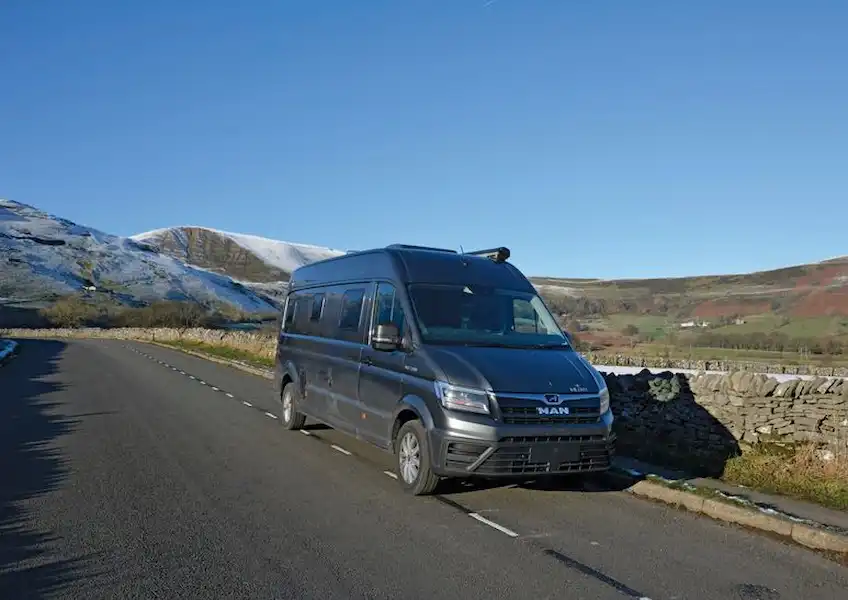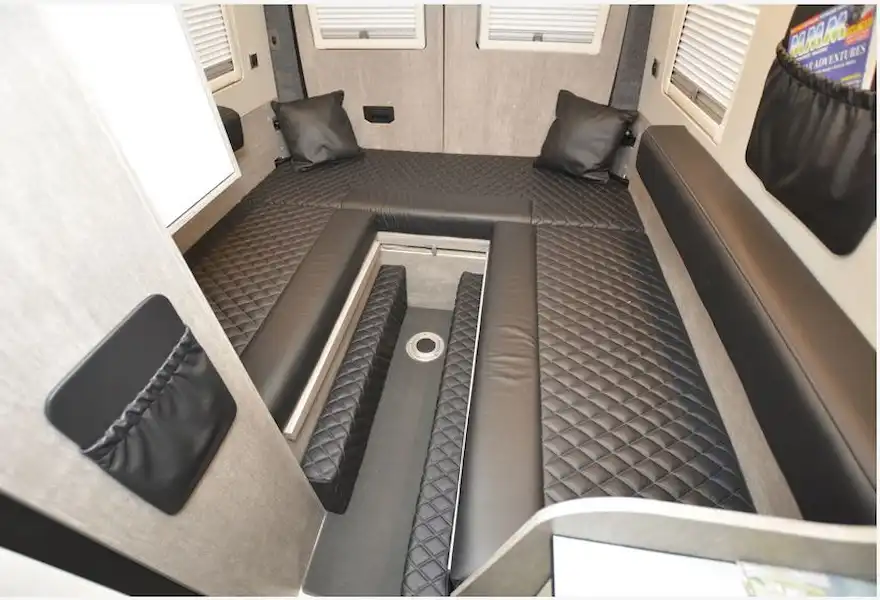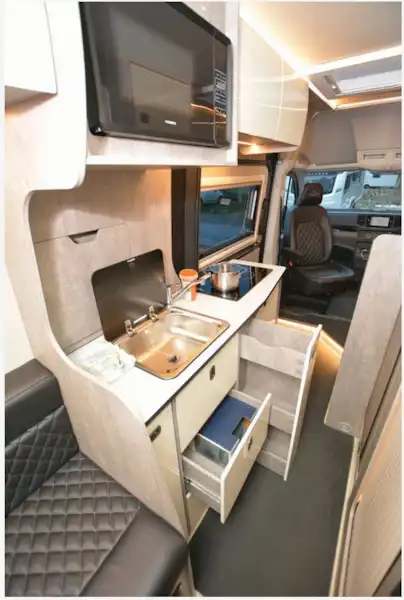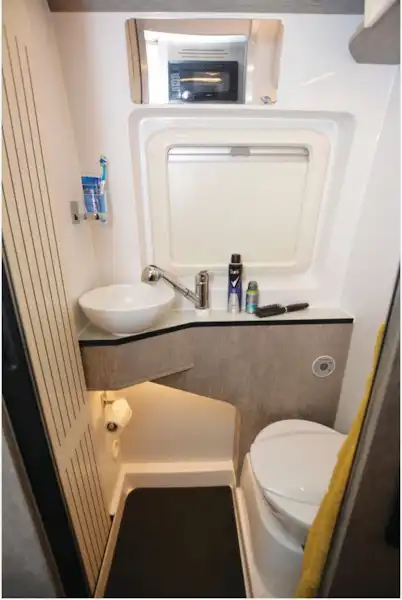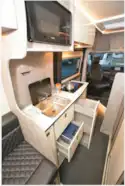Key Features
| Model Year | 2023 |
| Class | High top |
| Base Vehicle | MAN |
| Price From (£) | 92,995 |
| Length (m) | 6.83 |
| Berths | 3 |
| Belted Seats | 4 |
| Main Layout | Rear Lounge |
At a glance
WildAx's new gas-free flagship is the company's first campervan based on the excellent MAN TGE
Full review
Words and photos: Peter Vaughan
The WildAx Altair high-top campervan
Think MAN and you’ll probably imagine a 44-tonne artic thundering down the motorway. But now you can be a MAN van man, too, as the TGE takes the company down into the 3,500kg sector for the first time.
Of course, in today’s world of shared designs, this isn’t all MAN’s own work – the TGE is effectively a rebadged VW Crafter and it comes out of the same factory in Poland. But that’s no bad thing, as the big VW is the best to drive of all the large vans.
The MAN has already been seized upon for conversion by Knaus and Westfalia, and the latter being part of the same Rapido Group as WildAx has eased the Yorkshire company into a relationship with a brand that seems keen to get a foothold in the leisure market. So, the Altair made its debut at last October’s NEC show as WildAx’s new flagship, with MAN replacing Mercedes due to much better availability of the former.
Launched with a rear lounge, further Altair models are planned, offering either fixed high-level singles or a permanent double bed (each with a garage). All will use the long-wheelbase (6.84m) panel van, but a six-metre model could follow later.
The options
In addition to being longer than your typical campervan, what already sets the Altair apart is that it’s completely gas-free. WildAx has taken on board lessons learned from the Volt Pack option offered on its Fiat-based conversions and created a model that, as standard, uses only diesel and electricity for its habitation services.
Company MD, Duncan Wildman, is certain that this is the future for campervans, so the Altair banishing LPG is a logical step.
It’s also a refreshing change to be testing a campervan without a long list of options. Metallic paint and alloy wheels are just two features that you might have expected to pay more for but, in fact, the leather upholstery is the only extra-cost item here on the habitation side (the awning will not be offered as a factory-fit option, for weight/payload reasons).
Everything else is included in the £92,995 list price – although that is a substantial (£15k) more than a (6.36m) Fiat-based WildAx fitted with the Volt Pack.
The MAN
You’re rarely especially aware of the MAN’s extra length until you try to park in a town centre or manoeuvre into a tight spot. In which case, you’ll appreciate the Park Assist system’s sensors but might wish for the extra reassurance of a rear view camera.
Other than that, the TGE comes comprehensively equipped, although the plastic steering wheel rim seems like a throwback – we’re so used to the extra tactility of leather these days.
You’re sure to overlook that once you’ve covered a few miles in a MAN, though. The build quality (everything from the way the doors close to the fascia plastics), ride comfort and generally more sophisticated feel make the Fiat Ducato/Peugeot Boxer twins seem like something from a different age. This is much more like a Transporter T6.1 that has grown up.
The Altair comes with the 140bhp, 2-litre diesel engine, which, while not the most sparkling performer, is certainly perfectly adequate for a campervan. It was mated here to the optional automatic (an eight-speed torque converter transmission, not a twin-clutch DSG as in the VW T6.1) – that’s two grand well spent in my book, its smoothness being a match for any rival automatic on the market.
Unsurprisingly, the cab environment feels very Volkswagen. The heater controls, high-quality finish and clear instrumentation will make any Transporter (or Golf or Passat) driver feel at home. You’ll be comfortable, too, in a cab seat with twin armrests (oddly not in leather, unlike the rest of the seat), a height and tilt-adjustable squab, and even electric lumbar support variation.
Standard spec also includes cab air-conditioning, cruise control, ESC, stop/start, automatic lights and wipers and an upgraded 9in touchscreen for the DAB radio and sat-nav (as well as wireless Apple CarPlay and Android Auto). Its screen is smooth glass like an iPhone.
Conditions were more than a little wintry as we headed from WildAx’s Elland factory into the Peak District, but the Altair felt more like a supersized MPV than a van. Its slim width (compared with a coachbuilt) suited the country roads and the superior suspension ensured that there were not many rattles coming from the habitation area.
The interior
So, the TGE is a big step up from a Ducato but there’s also big step into the Altair. Entry into the living area is via the sliding door but WildAx has found it impossible to fit a step here due to the location of the fuel tank. It will, therefore, provide a free-standing step, without which it’s around 500mm from the ground into the campervan.
Of course, there are the rear barn doors, too, but the U-shaped lounge blocks these off. What that does allow, though, is a generous rear boot – 580mm deep, 380mm tall and 1.74m across the width of the campervan – for all your outdoor gear, from wellies and barbecue to levelling wedges and mains lead (as well as a home for the awning handle, clipped into place).
But will you need a mains lead? That was our first test. With an all-electric kitchen and diesel heating, WildAx has boosted the Altair’s on-board resources by fitting two 100Ah lithium batteries, 400W of solar power and a 3kW inverter. Switch on the latter and we’d have 230V at the sockets ( for my coffee machine), while the induction hob served up a bedtime cocoa and the microwave cooked my M&S Chicken Tikka Masala.
Arriving at the Caravan and Motorhome Club’s Castleton site around 3pm on an icy/foggy winter day, we wouldn’t see any benefit from the solar panel and didn’t hook up, but our batteries were 100% charged. By 9.30am next morning, having run the heating almost constantly, we were down to 45%, so one night off-grid in these worst-case scenario conditions is doable and much longer in better, brighter weather, especially when touring (topping up the batteries as you drive).
The layout
The layout of the Altair is a British classic, featuring not just a spacious rear lounge but a half-dinette up front that adds two extra travel seats, a dining area and an occasional kiddy bed. Here, the cab chairs rotate easily to join a wall-mounted table and a rather-too-upright bench seat, while the lack of any overcab shelf or cupboard means no banged heads and a much greater impression of space.
The zone makes a good area for meals, with a sturdy table and plenty of room for two, and there’s a mains socket adjacent (the only other one being at floor level in the rear).
Of course, it’s the end lounge that’s the reason to buy and here there’s plenty of space to put your feet up and relax. The dark leather might seem a bit manly (MAN-ly?), but it’s well finished with diamond stitching, and alternatives are available.
The side windows are smaller than you might expect, so it’s a cosy space with less of a goldfish bowl feel than some (which you prefer will be a personal matter). With four opening windows and a small rooflight, there’s plenty of ventilation. You can add a petite (wobbly) island leg table for drinks and there’s more than enough lighting, too, but the LED strips under the top cupboards can seem harsh. I’d have liked these to be dimmable and for there to be reading lights both here and in the cab. What isn’t in short supply is USBs – there are three double sockets in this lounge alone!
There’s plenty of room to store bedding under the offside settee (the nearside houses the electrics), and top lockers all around the rear lounge offer plenty of room for clothing, etc.
The beds
At night, it’s simple to convert this area into the main bedroom, either with single beds or a huge double. For separate sleeping, you just remove the backrest cushions but note that the offside bed is considerably shorter than its opposite number (although there’s plenty of room for feet to go under the overhanging wardrobe).
Alternatively, two vented panels slide out and fill the aisle, topped by the side backrest cushions. It’s a supersized double (and completely flat and ridge-free), but still shorter on one side, albeit with room, perhaps, for feet to share the middle ground.
I found the double very comfortable but was troubled overnight by the knock-knock sound of the diesel heating (it’s much quieter on 230V). Before that, settled under the duvet, I realised that I had to get out of bed to turn off the lights as the only switches are above the sliding door (an issue that has now been addressed, following MMM’s feedback).
And, in the morning, when I wanted just a hint of daylight without reducing privacy, I discovered that the blinds open from the bottom – usually (and sensibly) flyscreens and blinds are fitted the other way around.
The kitchen
There’s lots of storage in the galley, too, which really excels itself with six deep drawers and a tall pull-out pantry unit for tins and packets. Only the omission of a specific cutlery holder is a minor criticism.
There’s also a reasonable amount of worktop space and this becomes generous once you deploy the flap adjacent to the sliding door. Opposite the main kitchen, even the fridge is XXL – its 154-litre capacity is accessed by a door that opens from either side and, naturally, it’s a compressor model (with quiet mode for night-time) to suit this campervan’s gas-free vibe.
Simply switch on the inverter and you can use both the induction hob and the microwave wherever you are, not just when on a hook-up, but, with such a reliance on electric power, it seems odd to find no three-pin sockets in the kitchen. If you want to use a toaster or coffee machine, it’ll have to go on the dining table.
The washroom
Opposite the galley, a tambour door slides back to reveal a compact but practical washroom. It has the superior-quality Dometic toilet and a round ceramic washbasin mounted on the counter (which has enough space for toiletries alongside).
Both an opening window and a roof vent provide ventilation and there are all the usual accessories – toothbrush mug, loo roll holder, towel ring and robe hooks.
There’s not a huge amount of space, though, so it’s worth checking out the shoulder room on the throne as well as manoeuvring space when showering. I found both adequate but larger folk may struggle.
When it comes to hosing yourself down, the basin’s tap (which is awkwardly placed when you just want to rinse your hands) pulls out to become the showerhead, with a spray instead of a jet. Thankfully, there’s no clingy curtain to entrap you but, after your shower, you will need to wipe down the loo and encourage soapy water towards the single drain in the shower tray.
More of an issue was that, on day three of our test, after an overnight temperature of minus four degrees, the underslung ‘winterised’ tanks had temporarily frozen up, sending your Road Test Editor to the site facilities instead.
Where to buy
WildAx has established a network of dealers all around the UK. In Scotland It is represented by Highland Campervans and Motorhome Escapes.
In the northwest, WildAx is covered by E S Hartley, with outlets in Cumbria and Cheshire, while in the east of the country, it’s Maple Garage, near Hull.
In the Midlands, Geoff Cox Leisure (near Derby) is the dealer, while further south, WildAx vehicles are at Nick Whale (Evesham), Southern Motorhome Centre (Bracknell), Wiltshire Motorhomes (Melksham), Highbridge’s Devon branch (at Newton Abbot) and Specialist Vehicles GB in East Sussex.
Motorhome supplied by WildAx Motorhomes
Tel: 01422 372111
wildaxmotorhomes.com
Insurance: £773
Tel: 0800 975 1307
shieldtotalinsurance.co.uk
For quote details: motorhome.ma/QuoteInfo
Expert motorhome advice to your door!
Why not subscribe to one of our fabulous magazines and get expert advice, travel ideas, technical help and all the latest news for your motorhome and your motorhome adventures!
Want to know more about MMM magazine?
Every month MMM has articles written by motorhomers who have been there and done it, from great UK and European (and further afield) tours, campsite reviews, owners' reports and DIY projects among other things. MMM's tests, reviews and expert buying guides are not to be missed. MMM's technical advice is a must and includes everything from weekend jobs to longer-term DIY projects. And much more!
About MMM magazineWant to know more about What Motorhome magazine?
Every issue of What Motorhome magazine provides essential buying advice for anyone looking to buy a new motorhome or campervan or upgrade their existing model. With a pedigree of over 30 years of offering the best motorhome and campervan buying advice, every issue of What Motorhome includes more new motorhome and campervan reviews than you will find in any other magazine.
About What MotorhomeWant to know more about Campervan magazine?
Campervan is the exciting monthly magazine that will give you all the inspiration you need to explore the world in your campervan. Every issue is packed with real-life campervanning experiences, inspiring travel ideas in the UK and further afield, the best campsites to stay on, campervan road tests and reviews of the latest models, and much more!
About Campervan magazineOur verdict
The MAN base vehicle adds hugely to the appeal of WildAx’s new flagship, while the classic layout, generous and well-planned storage, as well as its gas-free camping ability for off-grid touring, ensure that the Altair should do well. We’d just like to see improvements to the interior lighting and a few minor details, and look forward to seeing the MAN/WildAx partnership grow in the years ahead.


